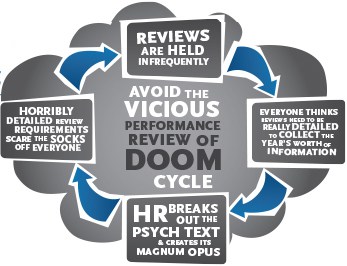
by thepeopleplan | Jul 24, 2013 | action plans, training and development
Our prior article “What Drives Engagement?” listed the top 10 engagement drivers.
Three areas impact employee perceptions of available development and career opportunities (category 4):
1. Enjoy challenging work assignments that broaden skills
2. Improved my skills and capabilities over the last year
3. Have excellent career advancement opportunities
Many people are comfortable and happy in their current job and do not wish to take on additional responsibilities.
Others crave challenging work and the opportunity to learn and grow. A key component in keeping the second group of employees at your organization is to figure out how to meet these needs.
If you are small business, you usually do not have a “career paths” or a training department. However, you have many informal opportunities for additional development—these include cross-training, job enrichment, project assignments, and team lead opportunities.
It is always best to have a “back up” for each role– and developing someone as a backup cross-trains another team member and gives a sense of skill development. Job “enrichment” means learning a bit deeper or broader on current tasks, such as increasing knowledge of accounting principles or equipment repair. We can always learn more about the work we do.
Even if your organization does not have “layers of management,” some employees are interesting in a newly emerging role of team leader. Team leaders are the “go-to” people who peers ask for help or to get another opinion for a decision. They often assist managers with routine supervisory tasks such as scheduling, assigning specific work, compiling reports, and side by side skill training. You may have someone now that is informally in this role.
Three steps you can take NOW to improve employee perceptions of development opportunities
- Think of one project or ongoing task that would be a stretch assignment for a team member, and delegate to someone with the competencies to accomplish.
- Spend 30 minutes one morning each week meeting with a team member to discuss “What skills or knowledge do you want to develop in the next year? How can this be accomplished?” Then create a timeline and action plan to achieve.
- Identify and start developing a team leader: If you have a great performer with interpersonal skills and a desire for additional responsibility, start with delegating a routine team task (scheduling, weekly project report, train new employee). If this person continues to grow in this role, create a team leader position with specific responsibilities and coach to achieve.
Two articles for more reading
For a source of stretch assignments, read our People plan article: “Too busy to delegate”
Inc Magazine article How to Tell If Your Employees Are Bored
Image courtesy of basketman at FreeDigitalPhotos.net

by thepeopleplan | Jul 24, 2013 | culture
Our prior article “What Drives Engagement?” listed the top 10 engagement drivers.
Two areas impact employee perceptions of their relationship with the supervisor (category 3):
1. Good relationship with supervisor
According to author James Robbins in his book “9 Minutes on Monday,” trust is the key component in a good relationship with your direct reports. He suggests a weekly “walkabout” to spend a few minutes talking informally with one team member to discuss something personal (not about work!) to show that you care.
2. Input into decision-making in my department
You don’t have to abdicate a decision to employees to get their input and improve their perceptions of “having a say.” Read our related post about “Total Reward #5 Autonomy” that shows a graph of the continuum of decision-making involvement
Three steps you can take NOW to improve employee perceptions of their relationship and role with (you) their direct manager:
- Schedule a time each week to do your “walkabout” to chat about the personal life of one employee.
- Find one moderately important decision you need to make soon, hold a meeting where you outline the issue and ask everyone to give input, discuss the ideas without “shooting them down” (you can share your thoughts and why you are considering this approach), and be sure to thank everyone for their contributions.
- After you have made the final decision, communicate this with your reasoning, again with recognition and appreciation for everyone’s input.
Article for more reading:
How to be a Better Boss in 2013 by leadership expert Jack Zenger (great tips here based on study of thousands of managers rated by their employees!)

by thepeopleplan | Jul 17, 2013 | culture, performance
Our prior article What Drives Engagement? listed the top 10 engagement drivers.
Two areas impact employee perceptions of what the organization values (category 2):
#1. “(My boss) sets high personal standards”
- Share what excellence and success looks like in their job (do you have any key performance indicators to discuss/ share/ track?)
- Hold everyone accountable to do their job to expectations (including yourself- walk the walk)
#2. “Organization encourages innovative thinking”
- Listen to new ideas and process suggestions, thoughtfully consider and discuss the viability of the idea
Three steps you can take NOW to improve employee perceptions of work standards and innovation:
- Regularly discuss work load and priorities, find out if team members have the tools and information to complete their tasks, and invite updates to re-direct if things aren’t on track
- Manage by results, not micromanage the process—this allows your team member to come up with a different (and often better) way to achieve the same outcome, then occasionally have staff share their methods with others doing the same task
- Ask your team- “What is one thing that could be improved for better customer service or to reduce a big hassle?” Then outline an action plan, assign tasks with deadlines, and revisit at your weekly meeting to implement this innovative improvement
Two articles for more reading:
It’s a fine line between setting high standards and being demanding. Read what NOT to do on Forbes: 10 tips on for dealing with an overly demanding boss
For tips on getting more practice at innovative thinking and turning into a habit, read “Innovation Is Everyone’s Job” on Harvard Business Review
Image courtesy of Stuart Miles at FreeDigitalPhotos.net

by thepeopleplan | Jun 11, 2013 | culture
Top ten global engagement drivers
You have at least met (if not work with) someone who is NOT engaged– they show up and barely do the job.
What can be a delight for co-workers and managers is someone who is “actively engaged.” Engagement is when an employee expends discretionary extra effort in their job— studies show that about 20% of US workers fit this category but some organizations have more than 40% engaged workers.
What influences an employee to go “Above and beyond?”
I have grouped them into four categories and will discuss suggestions for improving these (see number 1 below) with future articles.
1. How the organization treats people
- Senior management sincerely interested in employee well-being
- Organization’s reputation for social responsibility
- Organization quickly resolves customer concerns
2. What is valued at the organization?
- Set high personal standards
- Organization encourages innovative thinking
3. Employee role/ relationship
- Good relationship with supervisor
- Employees feel they have input into decision-making in their department
4. Development and career opportunities
- Enjoy challenging work assignments that broaden skills
- Improved my skills and capabilities over the last year
- Have excellent career advancement opportunities
(Source : Towers Watson study of the global workforce, Closing the Engagement Gap)
Many managers may be surprised that social responsibility and how customers are treated impacts employee performance. But employees are always considering not just how they are treated, but also how others are treated, and want to take pride in their employer and the organization’s decisions and direction. (For example, I have a colleague who begrudgingly took a job at a local company that is under investigation by the DEC for polluting the neighborhood, and she is not exactly “proud” to promote her new position.)
Three steps you can take NOW to improve employee perceptions of how people are treated:
- Spend 10 minutes once a week going around to exchange “small talk” with employees, finding out more about their lives outside the office and what is important to them (bonus points if you know names of kids, grandkids, and pets as well as favorite hobbies)
- Ask your key team members to suggest one way the organization can improve social or environmental responsibility, and then implement this idea
- Decide one way customers requests can be fulfilled more quickly or conveniently.
Thanks to Terry Williams of the Brain Based Boss for alerting me to this interesting research.

by thepeopleplan | Jun 1, 2013 | performance
This graphic and suggestions are from Cornerstone OnDemand (HR software for small business):
“Most of us are still a little battle-scarred after years of terrible reviews. But it’s not too late to fix reviews – to make them useful instead of something to be dreaded. ”
It’s all in your approach…
- Great organizations position reviews as part of everyday operations (not as an HR function).
- Great employees welcome feedback as a source of inspiration, motivation and reassurance.
- Great performance management systems encourage everyone to collect information on performance incrementally, and return that information to the organization to assist in decision making.
- Great managers talk about performance every day, giving timely (and useful) feedback to staff.








